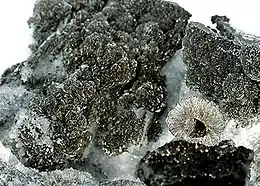| Rammelsbergite | |
|---|---|
 | |
| General | |
| Category | Mineral |
| Formula (repeating unit) | NiAs2 |
| IMA symbol | Rmb[1] |
| Strunz classification | 2.EB.15a |
| Crystal system | Orthorhombic |
| Crystal class | Dipyramidal (mmm) H-M symbol: (2/m 2/m 2/m) |
| Space group | Pnnm |
| Unit cell | a = 4.759 Å, b = 5.797 Å c = 3.539 Å; Z = 2 |
| Identification | |
| Color | Tin white with a faint pinkish hue |
| Crystal habit | Rarely as prismatic crystals; commonly massive, granular, radial, fibrous |
| Twinning | On {101} |
| Cleavage | Distinct on {101} |
| Fracture | Irregular |
| Tenacity | Brittle |
| Mohs scale hardness | 5.5–6 |
| Luster | Metallic |
| Streak | Grayish black |
| Diaphaneity | Opaque |
| Specific gravity | 7.0–7.1 |
| Optical properties | Strongly anisotropic |
| Pleochroism | Weak, yellow to pinkish hue and bluish white |
| References | [2][3][4] |
Rammelsbergite is a nickel arsenide mineral with formula NiAs2. It forms metallic silvery to tin white to reddish orthorhombic prismatic crystals, and is usually massive in form. It has a Mohs hardness of 5.5 and a specific gravity of 7.1.
It was first described in 1854 from its type locality in the Schneeberg District in Saxony, Germany. It was named after the German chemist and mineralogist, Karl Friedrich August Rammelsberg (1813–1899).[3]
It occurs as a hydrothermal mineral in medium temperature veins association with skutterudite, safflorite, lollingite, nickeline, native bismuth, native silver, algodonite, domeykite and uraninite.[2]
See also
References
- ↑ Warr, L.N. (2021). "IMA–CNMNC approved mineral symbols". Mineralogical Magazine. 85 (3): 291–320. Bibcode:2021MinM...85..291W. doi:10.1180/mgm.2021.43. S2CID 235729616.
- 1 2 Handbook of Mineralogy
- 1 2 Mindat.org
- ↑ Webmineral data
- Mineral Galleries
- Schumann, Walter (1991). Mineralien aus aller Welt. BLV Bestimmungsbuch (2 ed.). p. 223. ISBN 978-3-405-14003-8.
This article is issued from Wikipedia. The text is licensed under Creative Commons - Attribution - Sharealike. Additional terms may apply for the media files.